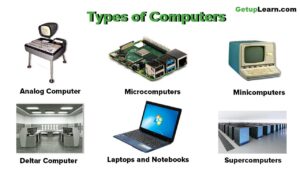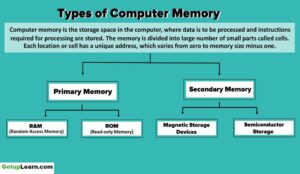Table of Contents
What is Storage Device?
Storage devices (auxiliary) are needed to permanently save data and programs until they are needed at which time the computer will load them from secondary storage into primary memory.
The general term for the secondary storage containers of data and programs is “files”; however, the term is so general that it has many, often confusing, uses. So, let us first understand the concept of a file here.

Table of Contents
It should be remembered that, although humans envision files containing the number, words, pictures, sounds, etc., everything on secondary storage (as well as in primary storage) are actually composed of bits (binary digits, i.e., 0 or 1) which are the only forms that can be processed by digital computers.
Some examples of data files, with a human view of their contents, are:
- Database files or flat files (often confusingly called “data files”, simply, “files”) contain files that contain records that further contain fields.
- Text files which can be encoded using ASCII or the newer 16-bit Unicode or as “document” files in which formatting is encoded along with the text, e.g. the “.doc” files of Microsoft Word. (See the Note at the end of this section.)
- Spreadsheet files consist of tables of numbers, formulas, or text; the basic unit called a “cell”, is the intersection of a row and a column.
- Graphic files contain two basic forms (bitmap images and vector graphics).
- Audio files contain digitized sounds, and vi) video files contain multiple bitmap images that are displayed sequentially (e.g. 30 frames per second) to give the illusion of motion video.
Advantages of Storage Devices
The advantages of storage devices are given below summarises the need for secondary storage devices:
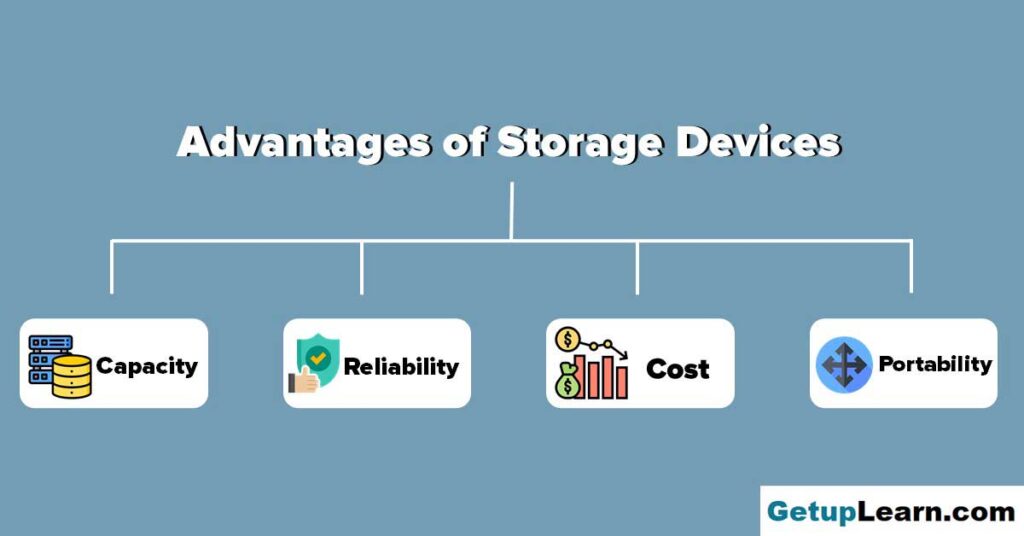
Capacity
Organizations may store the equivalent of a roomful of data on sets of disks that take up less space than a breadbox. A simple diskette for a personal computer holds the equivalent of 500 printed pages or one book. An optical disk can hold the equivalent of approximately 400 books.
Reliability
Data in secondary storage is basically safe since secondary storage is physically reliable. Also, it is more difficult for unscrupulous people to tamper with data on a disk than data stored on paper in a file cabinet. l Convenience. With the help of a computer, authorized people can locate and access data quickly.
Cost
Together the three previous benefits indicate significant savings in storage costs. It is less expensive to store data on tape or disk (the principal means of secondary storage) than to buy and house filing cabinets. Data that is reliable and safe is less expensive to maintain than data subject to errors.
But the greatest savings can be found in the speed and convenience of filing and retrieving data.
Portability
Data stored in detachable secondary storage devices can be used across various computers without much difficulty.
Types of Storage Devices
Basically, types of storage devices are classified broadly into two categories. They are:
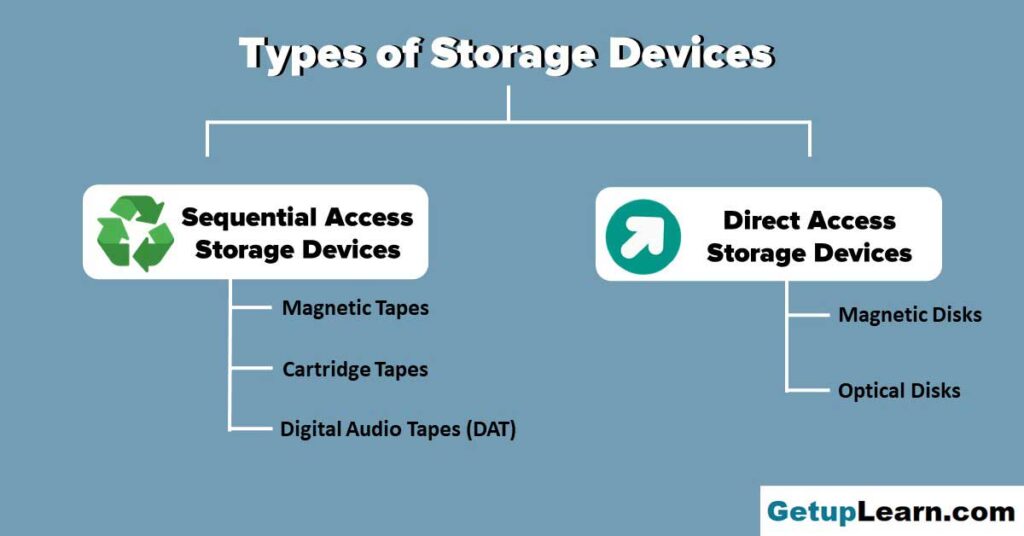
Sequential Access Storage Devices
In Sequential access devices, the data has to be accessed in a pre-defined sequences. This also applies to analogue media like videotapes and audiotapes.
The idea even predates magnetic computer storage, e.g. data used to be stored by punching holes in paper tapes. Magnetic tapes and Cartridge/cassette tapes are good examples of sequential access storage devices.
The following are the characteristics of sequential access storage devices:
- No direct access, but very fast sequential access.
- Resistant to different environmental conditions.
- Easy to transport, store, cheaper than disk.
- Before it was widely used to store application data; nowadays, it is mostly used for backups or archives (tertiary storage).
Sequential Access Storage Devices Examples:
Magnetic Tapes
Magnetic tapes are similar to the commonly used audiotapes. It is a long roll of flexible plastic material with a magnetic coating.
The magnetic coating consists of small particles of iron oxide mixed with a binding material. Data is stored as a magnetic pattern of bits on tracks that run the length of the tape. A magnetic spot represents a 1; no magnetic spot represents a 0.
In a magnetic tape unit, the read-write heads are kept stationary and the tape is moved past them (See the figure below). The tape unwinds from one reel, passes through the read-write mechanism, and winds on to the second reel.
A tape contains 9 tracks, 8 for a byte of data and one for a parity bit used for checking for errors. Each character or byte of data is recorded across the tape, with one bit of the character or byte on each track. The remaining tract is used for checking the accuracy of recording.
When data is recorded on a tape it may get corrupted due to some malfunction of the system. Such corruption of data may occur even when the tape is not in use. Several methods are available for detecting such errors.
Cartridge Tapes
These tapes are quarter-inch wide and are sealed in a cartridge much like an audio cassette tape. Unlike a half-inch tape discussed in section 3.4.1 above, these tapes record information serially in a track with one head. When the end of the tape is reached the tape is rewound and data is recorded on the next track.
There are 9 to 30 tracks and data is recorded in a serpentine fashion. Data bits are serial on a track and blocks of around 6000 bytes are written followed by error-correction code to enable correction of data on reading if any error occurs.
The density of these tapes is around 16000 bpi in modern tapes. The tape store is around 500 Mb. These tapes are usually interfaced with a computer using SCSI standards.
Digital Audio Tapes (DAT)
This is the latest addition to the tape family. This uses 4 mm tape enclosed in a cartridge. It uses a helical scan, read after write recording technique which provides reliable data recording. Helical scan records at an angle to the tape. The head spins at a high speed while the tape moves. Very high recording densities are obtained.
The tape length is either 60 meters or 90 meters. It uses a recording format called Digital Data Storage (DDS), which provides three levels of error-correcting code to ensure excellent data integrity. The capacity of this tape is up to 4 GB with a data transfer speed of 366 KB/sec. This tape also uses the SCSI interface.
Direct Access Storage Devices
Direct access (often misleadingly called “random access”) is characteristic of disks. Thus the idea predates computer storage, e.g. phonograph records are direct access analog storage.
In order to store files on any disk that disk must be formatted, i.e. initialized so that data can be stored in an organized manner; this organization is characteristic of the Operating System (O.S.) being used.
Therefore a Windows-based computer can not read Mac files, Unix files, etc. unless special translation software is available. Formatting creates sectors and tracks (See below) on which the data is stored and creates a file directory (called a file allocation table or FAT in Windows) which is loaded into RAM along with the O.S. when the system boots.
Direct access storage is currently dominated by magnetic media (hard disks, removable hard disks, and floppies), but magneto-optical and read/write optical media (DVD, DVD-RAM, and DVD+RW) promise to revolutionize storage technologies.
Direct Access Storage Devices Examples:
Magnetic Disks
Magnetic disks are the most popular medium for direct-access secondary storage. A magnetic disk is a metal or plastic platter that resembles a groveless phonograph record. Like the songs on a sound tape, the data records organised on a magnetic tape must be retrieved according to the storage sequence.
And like the music, the data recorded on a magnetic disk can also be accessed in a sequence if they have been organised in a way that supports such retrieval. Read/Write heads are tiny electromagnets that can read, write, or erase the polarised spots that represent data on magnetic media.
When such heads are fastened to an arm in a disk storage device, they can be moved quickly and directly to any disk location to store or retrieve data.
This data is encoded as magnetic bit patterns, which can be created or read by the read/write head of the disk drive. Data is directly accessed by rotating the disk beneath an actuator (single disk) or access arms (multi-disk) which move the read/write head in and out across the tracks.
Types of Magnetic Disks:
- Hard Disks
- Diskettes (floppies)
- Hard Cards
- Cartridge Disk
- Magneto-Optical Disks
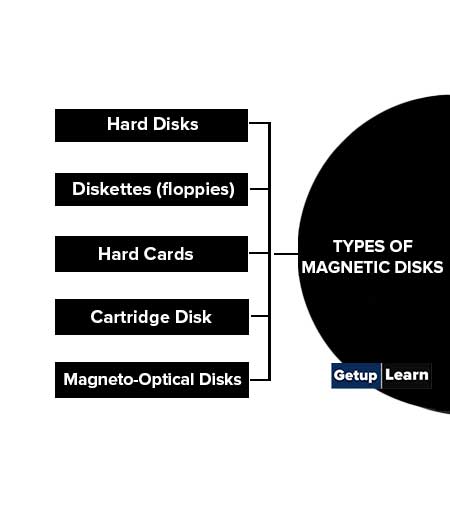
Hard Disks: are rigid aluminium platters coated with magnetic oxide whose high precision provide the highest storage capacities and quickest access rates of all magnetic media. This requires a contaminant-free environment; if contaminants do reach the disk surface a “crash” occurs where a scratch on the disk surface results in data loss.
Hard disks, currently reaching double-digit GB ranges, have the advantage of being the fastest mass storage but are permanent (i.e. the storage disks can not be switched). High-capacity storage units of all sizes that use sealed housings are often called Winchester disks.
Diskettes (floppies) are made of flexible Mylar plastic coated with magnetic oxide. They come in 8, 5.25, and 3.5-inch sizes, can have single (SD), double (DD), or high densities (HD), and can be either single- or double-sided.
Older diskettes, 5.25″ DD that hold 360 KB, 3.5″ DD that hold 720 KB, and 3.5″ HD diskettes that hold 1.4 MB are all virtually obsolete now because the LS-120 Super Drive (120MB) can store about hundred times the equivalent of an HD floppy and Sony’s HD (200MB) will be able to store about two hundred HD floppies! Both can read and write standard floppy disks as well.
Hard Cards are hard disks that are mounted directly on their interface card and fit directly into the expansion slots on a PC motherboard.
Cartridge Disk drives are devices that accept small removable (but hermetically sealed) disk cartridges (typically 3.5″ with 10 MB to single digit GB storage capacity.) This blend of the advantages of hard disks and floppies will, no doubt, revolutionise mass storage in the near future.
Magneto-Optical Disks (read/write/erasable) are often confusingly categorised as optical disks because lasers are used to read data as well as facilitate writing data. However, the data is stored magnetically in microscopic “magnetic domains”. When the high-power laser heats the magnetic storage film the domains can be aligned in higher densities than on regular magnetic disks, thus giving higher storage capacity than hard disks.
Data is retrieved by reflecting a low-power polarised laser beam off of the magnetic film. The polarisation of reflected beam can be interpreted as binary data.
Optical Disks
Data is encoded on the disk surface by a laser beam either burning holes (ablative method) or heating the surface until bubble forms (bubble method). Data, text, audio signals and video images are stored as digitised patterns in frames. Data is read when the surface reflects light through a series of mirrors to a photodiode (which converts light to electrical signals).
Digital data is represented as a series of Pits (a little depression, forming a lower level in the track) and Lands (the flat part between pits, or the upper levels of the track. The storage capacity is around 650 MB.
Types of Optical Disks:
- CD-ROM
- WORM
- Read/write Optical disks
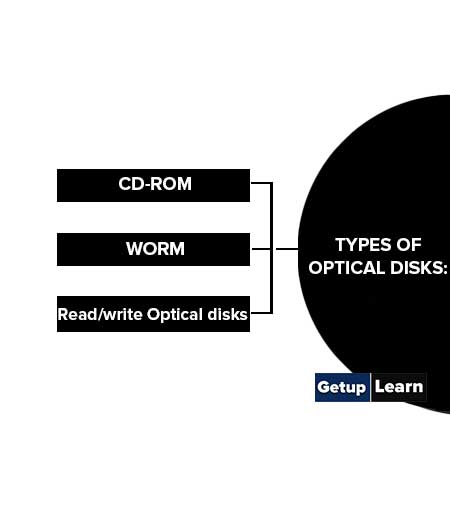
CD-ROM
CD-ROM is a read-only, removable medium with a large data storage capacity (630MB) which makes it is a suitable storage medium for the distribution and online use of encyclopedias and dictionaries; conceptually, CD-ROM data storage is similar to magnetic disk; data is stored in form of blocks on the disk.
The blocks can be arranged in files, with a directory structure similar to, although larger than, that of magnetic disks.
WORM: (digital data; Write Once Read Many) the most popular of which are recordable CD called CD-R, for compact disk recordable. l Video disk: (analog data, read only) stores text, graphics, video images, and audio signals.
Read/write Optical disks
Read/write capability has only recently been made possible on Optical media. (CD-ROMs have been available for a long time, but they are read-only. Also WORM (write once, read many) drives can not be used as secondary storage because data can be stored on them only once.) True read/write technology.
However, is becoming available and will, no doubt, revolutionize secondary storage capabilities. Technologies include CD-RW, DVD, DVD-RAM.






